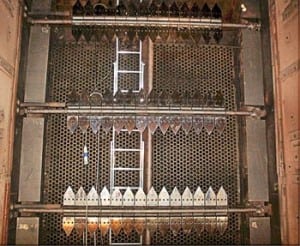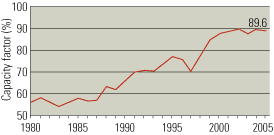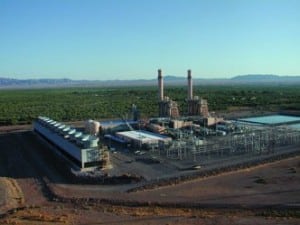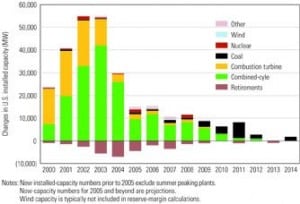-
Gas
Designing duct burners for variable GT loads
Duct burners use supplementary firing to increase the heat energy of a gas turbine’s exhaust, making it possible to increase the output of a downstream heat-recovery steam generator (HRSG). Early systems of the 1960s took a conventional approach to burner design. The exhaust of the turbine was directed into a windbox and then into a […]
-
Wind
Greener than thou
U.S. wind power is on a roll, with wind farms sprouting like weeds. But in the near future, utilities may end up paying higher prices for wind capacity because state regulators are, in effect, imposing an artificial floor on national demand for generation fueled by renewable resources. At last count, at least 20 states had […]
-
Gas
Global Monitor (May 2006)
Nuclear hot streak continues/Who’s winning in U.S. wind power?/ Canadian wind picking up too/ Brazilian port powers itself/ Biomass meets CHP in Sweden/ Power surfing from Scotland to Germany
-
Nuclear
Monster moisture separators
Thermal Engineering International (TEI) (USA) Inc. (Santa Fe Springs, Calif.)—a subsidiary of Babcock Power Inc. (Danvers, Mass.)—recently shipped two of the largest pressure vessels in the company’s 90-year history. The pair of huge (13-ft-diameter, 110-ft-long) moisture separator reheaters (MSRs) were designed at corporate headquarters and built in TEI’s factory in Sapulpa, Okla. The 300-ton MSRs […]
-
Coal
Big bucks for carbon sequestration
The California Energy Commission (CEC) recently awarded about $14 million for carbon sequestration projects to be overseen by the West Coast Regional Carbon Sequestration Partnership. Westcarb, as the partnership is known, is part of the U.S. DOE’s effort to deploy technologies through its Regional Carbon Sequestration Partnership (RCSP) program. New members Alberta and British Columbia […]
-
O&M
SWAT team helps shorten forced outage
Calpine Corp.’s South Point Energy Center in Mohave County, Ariz. (Figure 1) is a 520-MW natural gas-fired, combined-cycle facility with two Siemens Westinghouse 501FD gas turbines and one steam turbine-generator with a BB33 high-pressure (HP) section, a BB65 intermediate-pressure section (IP), and a 65CC intermediate/low-pressure (LP) section. The plant entered commercial service in June 2001. […]
-
O&M
Wireless vibration monitoring shows benefits
The 1,768-MW Baldwin Energy Complex in Illinois was the site of a joint-venture pilot project to demonstrate a wireless vibration-monitoring system for a coal pulverizer. The partners in the project were EPRI and the plant’s owner, Houston-based Dynegy Midwest Generation. A key objective of the project was to identify a reliable wireless system capable of […]
-
O&M
How important is IR detector resolution?
Stretching meager maintenance dollars is a way of life for most maintenance staff. In past years, the cost of an infrared (IR) camera usually came down to a choice between a low-resolution 160 x 120-pixel camera or no camera at all. If the camera was chosen, it usually became clear before long that low resolution […]
-
Legal & Regulatory
Facilitate plant siting by relaxing ratemaking constraints
The U.S. needs new generating capacity in coming decades to meet growing electricity demand. The increasing scarcity of land within utility load centers, combined with environmental opposition to the siting of plants, often limits siting options to remote locations. Restricting power plants to distant sites necessitates additional transmission facilities, increases delivery costs and electric bills, […]
-
Business
Balancing people, plants, and practices
An essential ingredient in the success of any business endeavor is thorough planning. We’ve all heard the axiom "proper prior planning prevents poor performance" or a variation on that theme. Why the need for peak performance? Competition within the industry has never been as intense, with utilities combining in search of economies of scale. The […]
Search










